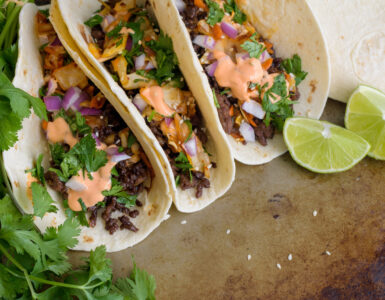A sourdough starter is more approachable than it sounds.
If a big, beautiful sourdough loaf is your end goal, then where do you start? The answer is sourdough starter! It’s a two-ingredient creation that requires a little TLC to get it where you want it, but it’s all worth it in the end.
Orson Gygi’s Heather Smith Smith shares some pointers to help you get started. She says a little love, patience, and fresh “food” every day will get it where you want it.
Find more food expertise on Instagram, @orsongygi, or at www.gygi.com.
Sourdough Starter Supplies You Need
- A FOOD SCALE: we are always going to suggest using a scale for accuracy! It will not only come in handy as you’re beginning a starter but with all of your baking from now on.
- SOME FLOUR: the type of flour you use is completely up to you. Some chefs will swear by only using whole-wheat and others say only to use bread flour – and we’ve also seen success with all-purpose. We’ll be testing each of these three, but mostly just encourage you to use a flour that’s unbleached, as bleach will hinder your starter from thriving. That said, just make sure to stick with the flour you choose until your starter is well-established and can handle a change, so for at least the next two weeks, use the same flour every day/every feed.
- SOME WATER: regular old tap water will work well. If your tap water is fine to drink, it will be fine to use for your starter. There is some debate around this advice, too, because depending on where you live, there may be high levels of chlorine and chloramine in your tap water which could hinder the growth of your starter. If you’re worried, you can absolutely use filtered water for your starter, but we’re going for simple here!
- SOMETHING TO STIR YOUR STARTER WITH: our favorite choices are a long-handled plastic spreader or the GIR skinny spatula. Either one will allow you to scrape your container with ease after feeding your starter.
- A CLEAN CONTAINER OR TWO: when feeding your starter, we recommend transferring your starter to a clean container each day. However, that’s not totally required! You can keep using the same container every time. Just make sure to use something transparent or semitransparent so you can see the starter rise and fall. A regular mason jar or deli container will do the trick!
- CONTAINER COVER: a cover for your container can be almost anything truly. Set a plate on top, use a mason jar lid, cut up a floursack towel, and secure with a rubber band… Whatever you choose, just make sure it is NOT airtight. Your starter needs to breathe and the gasses that form need a way to escape the container. So just make sure your cover is loose or breathable.
ESTABLISHING YOUR STARTER
Before we can add our starter to our bread recipe and create a dough, the starter has to actually be established. This means, literally, that it has had enough time to ferment into a strong culture. There are a couple of important guidelines to remember:
- Make sure that whatever flour and water you choose to use on day one, you’re still using for every feed until your starter is established. Once established, it can handle a change in flour choice if you switch things up a bit, but only once it’s established.
- Don’t close your container airtight. Remember your starter needs to breathe and is developing carbon dioxide gasses that need a way to escape.
- Try to feed at the same time every day so bacterias have the same amount of time for growth after each feed. If you forget or feed a couple of hours early or late, it’s ok! Just keep going and try to stay as close to the 24 hour mark each time.
From the very first day, the first time you ever mix together flour and water, it will take roughly 10-14 days for your starter to get established and strong. The simplest process we could find is the schedule we’re following:
- DAY ONE: mix together equal parts flour and water in your container. You don’t need a ton, we are using 50 grams of flour with 50 grams of water. Then leave it alone for 24 hours. That’s it! You’ve begun!
- DAY TWO: Discard half of your mixture, then feed fresh flour and water using the 1:2:2 ratio. We recommend using a clean container, adding 50 grams of your mixture from day one, then discarding the rest. If you’re following along and used the same amounts we did on day one, keep 50 grams of your mixture (1 part), then feed 100 grams (2 parts) of fresh flour and 100 grams (2 parts) of fresh water.
- DAYS THREE THROUGH TEN: this will take anywhere from seven to ten days to do. Just keep repeating the process until the float test is passed (outlined below). Repeat the same process as day two: discard half your mixture, then feed the rest using the 1:2:2 ratio. Keep 50 grams of your mixture (1 part), then feed 100 grams (2 parts) of fresh flour and 100 grams (2 parts) of fresh water.
You’ll be getting to know your starter quite well during this time. You’ll notice it bubbling, rising, falling, repeating. Do not get discouraged if you don’t see any activity in the first few days! Just keep going. It will eventually get there, we promise.
THE FLOAT TEST
Once your starter can pass “the float test,” it is considered established and ready to bake with, as well as move onto maintenance feeding. You’ll notice around days 7-10, your starter will begin to smell yeasty and slightly sweet. It will double in size in the hours after you feed it and dome at the top, with a lot of visible bubbles. At this point, it’s time to test it.
Use a spoon to take just a small scoop-full of your starter and drop it into a bowl or glass measuring cup of water. If it floats, CONGRATULATIONS! You did it! Your starter is established and ready to bake with! If it sinks, it might need a few more feedings before its ready. Sometimes the process can take a couple of weeks, and sometimes troubleshooting is in order. Don’t fret, just trust the process and keep going.















Add comment